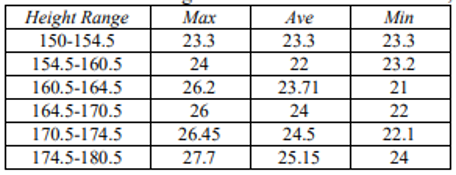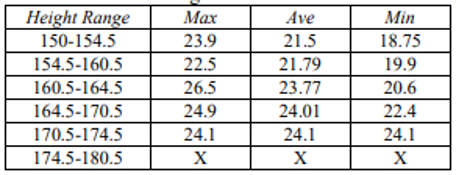The human body is considered the marvel of nature!
And why not? Isn’t it amazing that our body has some unique characteristics related to the lengths of different body parts?
We all know that every human is different in terms of his or her appearance. Even though some twins do look exactly the same, their fingerprints are different and so are their irises.
So, it is intriguing to know that though our bodies are so different to the extent of having a unique set of fingerprints for each person, why is it so that there exist striking similarities in the proportions of some of our body parts?
Yes, this is true.
Though we all look different, we have similarities in the lengths of certain body parts in relation to our heights. For example; there exists a definite relation between the height and the length of the forearm.
Several mathematical formulas have been developed to calculate the lengths of these body parts.
If you are curious to know how our height is linked to the forearm length, keep reading. We will have a look at different research studies that have tried to assess the relationship between height and forearm lengths. We will also learn the formulas that can help to find the forearm length or height of a person when the measurement of the other is known.
What is meant by the forearm length?
The forearm length is the distance measured from the tip of your elbow to the tip of the middle finger, with your arm flexed slightly at the elbow.
There are various ways to measure your forearm lengths. However, usually, it is measured in the sitting position by using an anthropometric chair.
Let us have a look at the step-by-step method to measure your forearm length using the anthropometric chair.
How to measure your forearm length in the sitting position?
Experts recommend sitting on the anthropometric chair for the more accurate measurement of the body dimensions.
The anthropometric chair is a commonly used tool for measuring nearly 34 dimensions of the body in different positions including standing, sitting, and the face area.
Let us now learn the step-by-step method to measure your forearm length using the anthropometric chair in the sitting position.
- The model of measurement of forearm length is the sitting position. Make sure you sit upright with your back straight without stretching or exerting strain on the back muscles.
- Tighten one forearm forward.
- Now, turn the 1st knob present on the upper arm gauge and then, turn the 3rd knob so that it rotates through 90 degrees.
- Now, turn the 2nd knob slowly until the acrylic part of the 3rd knob touches the fingertips.
- You can measure the distance between your elbow and the tip of the middle finger in this position with your upper arm held straight down and the forearm slightly bent forward.
- Note the reading. This measurement is called the forearm length in the sitting position.
If it is not possible for you to check your forearm length using an anthropometric chair, you may measure it at home with the help of a measuring tape.
You can ask someone to measure the distance from the elbow to the tip of the middle finger while you hold the arm slightly bent.
While this simple method can help you measure your forearm length more easily at home, the anthropometric method is considered superior for its higher accuracy.
Also, though the forearm length is considered to be the distance between the tip of the elbow and the tip of the middle finger, for research purposes, the distance between the elbow and the base of the wrist joint is measured for the evaluation of the link between height and forearm length.
What is the average forearm length in men and women?
Since the lengths of the forearm are dependent on the height of a person, variations are bound to exist between the forearm lengths of different individuals.
It is estimated that the average forearm length from the elbow to the wrist is about 24.90 cm
(between 24.6 cm to 25.2 cm). [1]
Several research studies were conducted to assess the anthropological measurements of a large group of people to find the average forearm length in men and women.
One study that was focused on finding the average forearm lengths have provided a fair idea of the estimate. This study involved the measurement of the forearm lengths of 1150 females and 480 males in the Lublin region.
This study showed that the length of the right forearm in men was between 20 and 30.5 cm with a mean length of about 25.40 cm. The average length of the left forearm in men was 25.3 cm with a variation between 20 cm and 30 cm.
The measurement of the length of the right forearm in women ranged between 19 cm and 31 cm with a mean length of 23.50 cm. The measurement of the left forearm in women varied between 19 cm and 33 cm with a mean length of 23.30 cm.
This shows that the average length of the foramen differs in men and women.
Also, there might be a minimal difference in the length of the right and left foramen of the same person. This study has also suggested that the average foramen lengths may be different for people belonging to different countries or races.
These variations could be attributed to the differences in the heights of people from different geographical regions.
Hence, though the average forearm length is considered to be 24.90 cm, this study has shown different results with a shorter forearm length in both the left and right hands in women and a longer forearm length in both the hands in men.
These factors need to be considered while calculating the forearm lengths. However, irrespective of the changes in the forearm lengths of people across the world, there exist similarities in how these lengths are related to the height of the person.
Some other findings of this study have provided insights into the link between the forearm length and the height of a person.
This study has shown that the lengths of the left and right forearms were often bigger in men compared to that in women. Also, in both men and women, the length of the right forearm was usually more than that of the left forearm.
Wide differences were also found to exist in the lengths of the forearms based on the age of the person.
The length of the forearm was found to be lower in relation to the age in males while in women it was found to be higher.
These are remarkable findings that need to be taken into consideration while calculating the height of a person based on his or her forearm length or vice versa. [2]
Now that we have learned what is meant by the forearm length and how to measure it, let us dive deeper to find how it is related to your height.
Estimation of the height based on the Forearm length
One research study aimed at estimating the height of a person based on the forearm length has provided interesting findings. The aim of this study was to compare the heights of different individuals in relation to their forearm lengths.
The objective was to arrive at a formula for determining the height from the forearm length.
This study was based on the concept that the estimation of the height of a person from the skeletal parameters bears huge importance in the medical science.
In addition to the use of long bones, like the humerus and femur, even the length of the forearm may be used for certain purposes in the medical field. Estimating the height to forearm length ratio could also serve as an important factor in the diagnosis and treatment of diseases and forensic science.
The results of this study have revealed that a positive correlation exists between the height and the forearm length of a person.
The statistical analysis and tabulation of the lengths of the forearms and heights of people led to the derivation of a regression equation that can be of great help in the field of forensic sciences, and for anatomists and clinicians.
This study has proven that the forearm length can be used as a parameter for estimating the height of an individual. [3]
Let us learn more about the findings of this study.
This research followed the methodology for estimating the stature based on the measurements of the length of the upper extremity. It involved randomly selected 300 participants between the age group of 18 to 22 years.
The data was collected while maintaining a high level of accuracy. The measurements of lengths were repeated to minimize errors. The measurements of the lengths of the forearm and the height of the participants were taken at a fixed time between 3 to 5 pm to eliminate the changes in the measurements due to the diurnal variation.
The height of each participant was measured from the tip of the head or the vertex to the heels and noted in centimeters. The measurements of height were taken in the barefooted standing posture.
The forearm length was measured in the arm-flex position using a standard measuring tape. It was measured from the point between the ulnar and radius tuberosities to the tip of the olecranon (the bony prominence present on the elbow at the upper end of the forearm bone called the ulna).
The results of this study provided evidence indicating that as the height of a person increases, the forearm length also increases in a definite manner.
Most of the women in this study had their heights in the range of about 150 cm to 154.5 cm. The number of samples of females with a higher forearm length was lower in the group of participants as compared to that in men suggesting that the average forearm length is lower in women than in men.
The maximum number of men in this study belonged to the middle of the height range (164.5 cm to 170.5 cm). Even in the case of males, it was observed that as the height increased, the length of the forearm also increased.
This indicated that it is possible to estimate the height of the individual from the length of the forearm.
The findings of this study are summarized in the tables provided below:
Height of men in relation to the lengths of their forearms
- Max: Maximum length of the forearm
- Ave: Average length of the forearm
- Min: Minimum length of the forearm

The table shows that the average, as well as the minimum and maximum length of the forearms in men, were lower in the groups of participants whose heights were in a range of 150 cm to 154.5 cm.
As the heights of the participants increased, the maximum, minimum, and average lengths of the forearms in these participants increased.
In the participants that belonged to the higher range of height of 174.5 cm to 180.5 cm, the average length of the forearm was the highest at 27.7 cm. This has clearly proven that the length of the forearm increases or decreases with the increase or decrease in the height of men, respectively.
Height of women in relation to the lengths of their forearms
- Max: Maximum length of the forearm
- Ave: Average length of the forearm
- Min: Minimum length of the forearm

The table shows that the average, as well as the minimum and maximum length of the forearms in women, were lower in the groups of participants whose heights were in the range of 150 cm to 154.5 cm.
As the heights of the participants increased, the maximum, minimum, and average lengths of the forearms increased. In the participants that belonged to the higher range of height of 170.5 cm to 174.5 cm, the average length of the forearm was the highest at 24.1 cm.
This has clearly proven that the length of the forearm increases or decreases with the increase or decrease in the height of the women, respectively.
These findings have led to the derivation of the formula for calculating the height of a person based on the forearm length.
The formula has been derived based on the graph plotted with points marked for the specific heights and forearm lengths in men and women.
The regression equation that is derived from this study is:
Height of a person = slope(X) + Intercept, wherein X is the forearm length of an individual.
Based on this, the regression equation for men can be derived as:
- Height of a man= -253.02 + 17.5(x)
The regression equation of the women can be derived as:
- The height of a woman = 32.11 + 5.74(x)
Variations in the formula for the estimation of height and forearm lengths
Another study has provided a similar formula that could be used to calculate the height of a person based on the measurement of his forearm length.
The formulas derived based on the findings of this study are as follow:
- Height in cm = 3.54 × forearm length (cm) + 73.69
- Height of men in cm = 2.108 × forearm length (cm) + 118.916
- Height in women in cm =1.109268 × forearm length (cm) + 112.461
The standard error of measurement is 6.21, 4.08, and 4.64 for the height of any person, for men and for women, respectively. [4]
Limitations to the height to forearm ratio
Several studies have shown that it is possible to calculate the height of a person based on the length of his or her forearm or vice versa.
The length of the forearm is directly proportional to the height of a person.
However, there are certain conditions that can create discrepancies in the proportion of the length of the forearm and the height.
For example, patients with diseases that affect their bones may have a higher or longer stature compared to what is expected based on the length of their forearm.
Let us have a look at how some diseases can affect the height to forearm length ratio.
Effect of osteogenesis imperfecta on the height to forearm length ratio
Patients who suffer from conditions that cause disproportional growth of the bones in the body may not have their height and forearm lengths in the proportions expected in normal individuals.
The forearm length is often considered a reliable tool for standardizing bone parameters of the forearm that are measured with the help of peripheral quantitative CT (Computed Tomography) scan in patients diagnosed with disproportional growth.
Research studies were conducted to investigate the relationship of the forearm length and height to the parameters of the health of the bones in the normal pediatric population as against that in the patients with osteogenesis imperfecta.
For this study, the data related to the forearm lengths of the participants was noted along with their heights. The measurements of the forearms as indicated by the imaging studies like peripheral quantitative computed tomography were also noted.
The data was collected from the group of participants that included 140 men and 156 women between the ages of 5 and 19 years.
The study also included 73 patients diagnosed with osteogenesis imperfecta among which 53 were men with the mean age of 11.7 ± 3.3 years.
The BMC (bone mineral content) measurements in these participants were transformed into SDS (standard deviation score) according to their forearm lengths and heights.
The results of this study showed that the height and the Tanner stages could significantly predict the forearm length in men and women. The height was found to be a stronger and a more reliable predictor for the forearm length than the Tanner stages.
Compared to the control group of participants, the data in patients with osteogenesis imperfecta was characterized by a lower BMC and SDS for both the forearm length and the height.
This study showed that the height to forearm length ratio was significantly lower in patients with osteogenesis imperfecta.
This indicates that the commonly used formulas for determining the height or forearm length of a person based on the measurement of the other may not be reliable in patients who suffer from diseases that affect the growth and development of the bones.
Also, there is a need to assess the forearm length to height ratio in patients with similar conditions so that appropriate formulas can be derived to assess the impact of these diseases on the child’s future height or forearm length. [5]
Conclusion
Research studies have provided a reliable base for calculating the height of a person when the forearm length is known or vice versa.
It is important to assess how certain factors influence the height to forearm length ratio so that a more accurate measurement of the body parts can be obtained.

